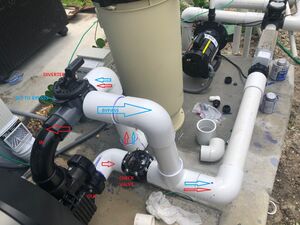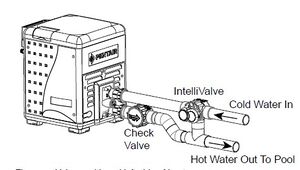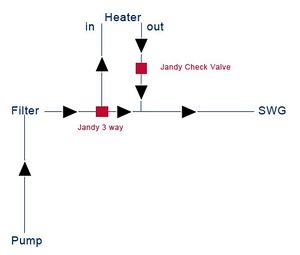| (13 intermediate revisions by 2 users not shown) | |||
| Line 17: | Line 17: | ||
*opening the pool in the Spring and balancing the water chemistry | *opening the pool in the Spring and balancing the water chemistry | ||
*the pH may fall below 7.0 | *the pH may fall below 7.0 | ||
| − | *using any | + | *using any chermical that may lower the pH below 7.0 |
| − | *the heater is not being used for periods of time | + | *the heater is not being used for periods of time in which case 90% of the flow should be bypassed and a small amount allowed to flow through the heater. |
Some heaters have an internal bypass to control how much water flows through its core while bypassing the remaining water directly out the heater. Others heaters may have an external bypass to limit the flow to not exceed the heaters maximum flow rate. Neither of those is the same as the heater bypass being discussed here since they cannot stop water from flowing through the heater core. | Some heaters have an internal bypass to control how much water flows through its core while bypassing the remaining water directly out the heater. Others heaters may have an external bypass to limit the flow to not exceed the heaters maximum flow rate. Neither of those is the same as the heater bypass being discussed here since they cannot stop water from flowing through the heater core. | ||
| + | |||
| + | Both Pentair with the [[Pentair_MasterTemp_Heaters#Automatic_Heater_Bypass|MasterTemp Automatic Bypass]] and Jandy with the JXI heater Versaflo have added an automatic bypass function that automatically turns flow into the heater on when the heater is turned on. Hayward has a “Smart Heater” with a controllable valve in its configuration. | ||
| + | |||
| + | Those automatic bypasses are set to allow a small amount of water to continue flowing through the heater when the bypass is on. The main reason that "some" water should continue to circulate through a heater is so that the water in the heater does not evaporate and leave deposits in the heat exchanger if un-used for a while.<ref>https://www.troublefreepool.com/threads/another-heater-bypass-hayward.266315/post-2330454</ref> | ||
| + | |||
| + | [[File:Pentair MasterTemp Connected Heater Bypass.jpg|thumb]] | ||
| + | |||
| + | It is interesting that JXi heaters are warranted for one (1) year and Heat Exchangers on JXi Gas Heaters with factory-installed VersaFlo Integrated Bypass are warranted for five (5) years. | ||
| + | |||
| + | When a heater is bypassed with manual valves it is important to shut off the heater because the pressure switch will still be activated and the heater could run with no flow. When in bypass, the power should also be shut off to the heater, just to be sure. It is best to install a [[Heater Flow Switch]] in series with the pressure switch to ensure the heater does not run with no water flow. | ||
| + | |||
| + | [[File:Heater Bypass Schematic.jpg|thumb]] | ||
For some unknown reasons many Pool Builders push back on the request to install a heater bypass. It is very simple requiring a 3 way diverter valve on the heater input line, a short length of PVC to connect to a T on the heater output line, and a check valve between the T and the heater output. In the picture above the red arrows show the water flow in normal heater operation and the blue arrows show the water flow when the heater is bypassed. The added cost and plumbing is minimal. | For some unknown reasons many Pool Builders push back on the request to install a heater bypass. It is very simple requiring a 3 way diverter valve on the heater input line, a short length of PVC to connect to a T on the heater output line, and a check valve between the T and the heater output. In the picture above the red arrows show the water flow in normal heater operation and the blue arrows show the water flow when the heater is bypassed. The added cost and plumbing is minimal. | ||
As described above there are many situations where a heater bypass is useful. Sooner or later in the life of the pool you will likely encounter one of them. And really there are no downsides in having the heater bypass line between the heater input and output pipes waiting for when you need it. | As described above there are many situations where a heater bypass is useful. Sooner or later in the life of the pool you will likely encounter one of them. And really there are no downsides in having the heater bypass line between the heater input and output pipes waiting for when you need it. | ||
| + | |||
| + | Also see the thread | ||
| + | [https://www.troublefreepool.com/threads/verifiable-benefits-of-a-heater-bypass-install.235641/#post-2062903 Verifiable Benefits of a Heater Bypass Install]. | ||
| + | |||
| + | =Heater Bypass for Maximum Flow Limit= | ||
| + | |||
| + | Gas heaters and Heat Pumps typically have a maximum water flow limit through its heat exchanger to prevent water from eroding the heat exchanger. This is usually less of an issue with gas heaters that have higher maximum flow rates then Heat Pumps. Gas heat exchangers typically have larger tubes then heat pumps and can take higher flow rates. | ||
| + | |||
| + | A setup that can encounter flow greater then the heater limits is a spa that heats through the spa jets and high flow is desired for a good spa experience. That flow can be greater then the limit of a Heat Pump or even a gas heater. | ||
| + | |||
| + | A manual 3 way valve can be installed to bypass some water flow and limit the flow through the heater. This may not work so well with a variable speed pump where the flow through the heater can vary. | ||
| + | |||
| + | There are automatic bypass valves like the [https://www.aquacal.com/wp-content/uploads/manuals/landingpage/air_source_user_hp9/en-us/Content/Resources/Topics_Manuals_QS/6%20Accessories/Available%20Accessories.htm AquaCal STK0135] that allow full flow through the heater until the flow reaches the limit and then the bypass opens and routes some water around the heater. AquaCal says: | ||
| + | *When high flow rates are outside recommended specifications, please use this kit or an alternative bypass valve system. | ||
| + | *This kit can be used to control excessive water flow through the heat pump. It provides automatic flow adjustments for most applications. | ||
Latest revision as of 14:55, 2 February 2024
Why a Heater Bypass Valve is a Good Thing to Have
Many pools have an expensive heater in their water flow. Water circulates through the heater core all the time the pump is running, whether the heater is on or off. If the heater springs a leak, you have to shutdown the pump, which stop waters circulation, filtering and chlorinating your pool. Having the pump stopped too long can lead to algae and a dirty pool, and more work once you get the heater repaired and the pump running again.
If you had a heater bypass valve, that switches the water flow to flow around the heater, you would just move it the bypass position and you can continue running the pump and circulating pool water normally while you get the heater repaired or replaced.
Most pool heater heat exchanger, which is a coil of pipe inside the heater, is made of copper. Low Ph, below 7.0 can cause the copper pipes to erode resulting in copper in the pool water and possibly leaks from the heat exchanger. Even if the copper erosion of the heat exchanger pipes is not serious enough to leak the copper in the pool water can cause stains in the pool.
With a relatively new pool or heater you may not see a leak for many years and wish you had a heater bypass valve. However you may encounter another situation where bypassing the heater is helpful. Heater cores can be damaged by acidic low pH below 7. Maybe you misjudged your acid addition and accidentally lowered your pH too much. If you have a heater bypass you can turn the valve and stop the acidic water from flowing through the heater. Or maybe you purposely lower the pH to around 7 to treat a scale problem. You can use the heater bypass valve to take the heater offline and protect the core.
Also, if you are in an area where you close your pool for the winter your water chemistry may need adjustments upon Spring opening and you may not be confident that your pH is stable while adding chemicals. You can bypass the heater and protect the copper core during the pool opening until your pH is stable between 7.2 and 7.8.
Water running through a heater all the time creates back pressure, slows the water flow, and makes the pump work harder running at higher RPMs using more energy. Especially if you have a heat pump which has smaller diameter internal piping then a gas heater. Some pool owners only use their heater 5% of the time, yet their water flow is restricted the 95% when the heater is not in use. Bypassing the heater during the hot summer months when it is not necessary can improve water circulation.
In summary, times the heater should be bypassed include when:
- the heater is leaking or needs repairs
- opening the pool in the Spring and balancing the water chemistry
- the pH may fall below 7.0
- using any chermical that may lower the pH below 7.0
- the heater is not being used for periods of time in which case 90% of the flow should be bypassed and a small amount allowed to flow through the heater.
Some heaters have an internal bypass to control how much water flows through its core while bypassing the remaining water directly out the heater. Others heaters may have an external bypass to limit the flow to not exceed the heaters maximum flow rate. Neither of those is the same as the heater bypass being discussed here since they cannot stop water from flowing through the heater core.
Both Pentair with the MasterTemp Automatic Bypass and Jandy with the JXI heater Versaflo have added an automatic bypass function that automatically turns flow into the heater on when the heater is turned on. Hayward has a “Smart Heater” with a controllable valve in its configuration.
Those automatic bypasses are set to allow a small amount of water to continue flowing through the heater when the bypass is on. The main reason that "some" water should continue to circulate through a heater is so that the water in the heater does not evaporate and leave deposits in the heat exchanger if un-used for a while.[1]
It is interesting that JXi heaters are warranted for one (1) year and Heat Exchangers on JXi Gas Heaters with factory-installed VersaFlo Integrated Bypass are warranted for five (5) years.
When a heater is bypassed with manual valves it is important to shut off the heater because the pressure switch will still be activated and the heater could run with no flow. When in bypass, the power should also be shut off to the heater, just to be sure. It is best to install a Heater Flow Switch in series with the pressure switch to ensure the heater does not run with no water flow.
For some unknown reasons many Pool Builders push back on the request to install a heater bypass. It is very simple requiring a 3 way diverter valve on the heater input line, a short length of PVC to connect to a T on the heater output line, and a check valve between the T and the heater output. In the picture above the red arrows show the water flow in normal heater operation and the blue arrows show the water flow when the heater is bypassed. The added cost and plumbing is minimal.
As described above there are many situations where a heater bypass is useful. Sooner or later in the life of the pool you will likely encounter one of them. And really there are no downsides in having the heater bypass line between the heater input and output pipes waiting for when you need it.
Also see the thread Verifiable Benefits of a Heater Bypass Install.
Heater Bypass for Maximum Flow Limit
Gas heaters and Heat Pumps typically have a maximum water flow limit through its heat exchanger to prevent water from eroding the heat exchanger. This is usually less of an issue with gas heaters that have higher maximum flow rates then Heat Pumps. Gas heat exchangers typically have larger tubes then heat pumps and can take higher flow rates.
A setup that can encounter flow greater then the heater limits is a spa that heats through the spa jets and high flow is desired for a good spa experience. That flow can be greater then the limit of a Heat Pump or even a gas heater.
A manual 3 way valve can be installed to bypass some water flow and limit the flow through the heater. This may not work so well with a variable speed pump where the flow through the heater can vary.
There are automatic bypass valves like the AquaCal STK0135 that allow full flow through the heater until the flow reaches the limit and then the bypass opens and routes some water around the heater. AquaCal says:
- When high flow rates are outside recommended specifications, please use this kit or an alternative bypass valve system.
- This kit can be used to control excessive water flow through the heat pump. It provides automatic flow adjustments for most applications.




